#chengdu museum
Photo

@zahahadidarchitects Zaha Hadid Architects’ Chengdu Science Fiction Museum to host Worldcon 2023 Read more: Link in bio! Visualization: ATCHAIN @atchain. Zaha Hadid Architects: The city of Chengdu is a leading incubator of science fiction writing in China. Launching the careers of many of the country’s most renowned authors, ‘Science Fiction World’ magazine has been published in the city since 1979 and is the genre’s most popular periodical worldwide. Surrounded by mountain ranges and forests, Chengdu cultivated a unique local culture rooted in its rich history that includes the mystical visions and extraterrestrial forms within the carvings and masks of the Bronze Age Sanxingdui civilization. The capital of Sichuan province in Southwest China, Chengdu has grown to a city of over 20 million residents and become important global center of scientific innovation and research… #china #chengdu #museum #архитектура www.amazingarchitecture.com ✔ A collection of the best contemporary architecture to inspire you. #design #architecture #amazingarchitecture #architect #arquitectura #luxury #realestate #life #cute #architettura #interiordesign #photooftheday #love #travel #construction #furniture #instagood #fashion #beautiful #archilovers #home #house #amazing #picoftheday #architecturephotography #معماری (at Chengdu, China) https://www.instagram.com/p/Cnm1yOQuQa1/?igshid=NGJjMDIxMWI=
#china#chengdu#museum#архитектура#design#architecture#amazingarchitecture#architect#arquitectura#luxury#realestate#life#cute#architettura#interiordesign#photooftheday#love#travel#construction#furniture#instagood#fashion#beautiful#archilovers#home#house#amazing#picoftheday#architecturephotography#معماری
42 notes
·
View notes
Text
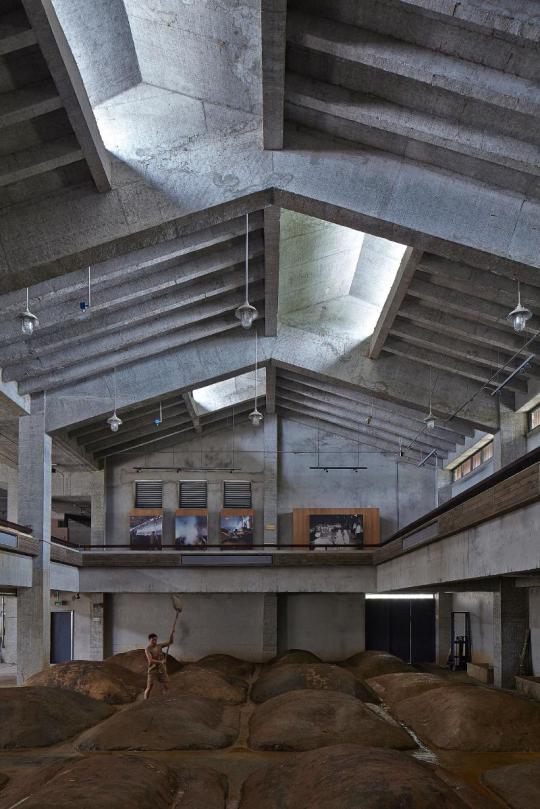
SHUIJINGFANG MUSEUM by JIAKUN ARCHITECTS. Image via Divisare. Photos by Archexist.
2 notes
·
View notes
Text

Chengdu Science Fiction Museum by Zaha Hadid Architects
6 notes
·
View notes
Photo

Muda Architects models Tianfu Museum of Chinese Medicine on yin-yang symbol
Chinese studio Muda Architects has revealed its design of a museum in Chengdu that will be dedicated to the history of Chinese medicine and arranged in the shape of the yin-yang symbol.
Named the Tianfu Museum of Chinese Medicine, the 13,000-square-metre building will occupy a site beside Huitong lake in Pengzhou.


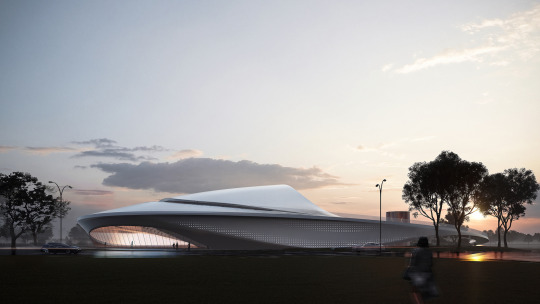
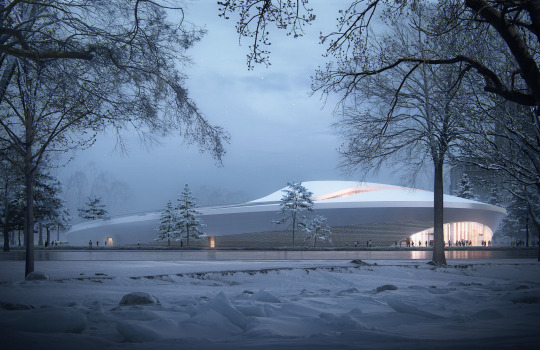
#muda architects#architectural design firm#architecture#tianfu museum of chinese medicine#yin-yang symbol#chengdu#history#huitong lake#pengzhou#future architecture
4 notes
·
View notes
Text

desde Blog Arte Plus:
Museo de ciencia ficción Chengdu por Zaha Hadid Architects.
[ acceder ]
#arquitectura#architecture#edificios#building#Zaha Hadid#Zaha Hadid Architects#chengdu#china#Museo#museum#ciencia ficción#sci fi
0 notes
Text
Inside the Censorship Scandal That Rocked Sci-Fi and Fantasy's Biggest Awards
1 note
·
View note
Text
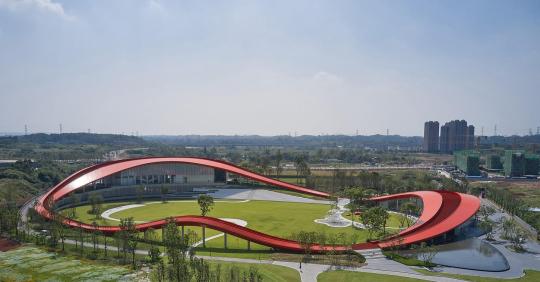
#Loop of Wisdom Museum and Reception Center#Chengdu#China; architect: Powerhouse Company (2020). The two buildings are connected with a bright red rooftop walkway made from rubber asphalt so
0 notes
Text

‘Faces of Sanxingdui’: Bronze Age Relics Shed Light on Mysterious Ancient Kingdom
A golden face with patinaed turquoise eyes stares out of the darkness. Illuminated around it stand three other bronze heads — some have flat tops, others round — all looked over by a giant bronze statue almost 9 feet high. All have the same piercing, angular eyes.
There’s something about the “Faces of Sanxingdui” — as this collection of sculptures is being billed — that feels both familiar and alien. Currently on display at the Hong Kong Palace Museum, they may appear Mayan or Aztec to the untrained eye, but these over-3,000-year-old sculptures weren’t unearthed anywhere near Mesoamerica’s ancient civilizations. They were discovered on China’s Chengdu Plain, at an archeological dig site called Sanxingdui (which translates as “three star mound”).
Thought to be the largest and oldest site left by the Shu kingdom, a civilization in southwestern China once only hinted at in myths and legends, Sanxingdui was not discovered until the 1920s, when a farmer stumbled across objects while digging an irrigation ditch. The site has since been found to contain the ruins of an ancient city made up of residences, sacrificial pits and tombs enclosed by high dirt walls. Archaeologists from the Sanxingdui Museum say the city was established some 4,800 to 2,800 years ago, until it was abandoned around 800 BC for unknown reasons.

The Chinese government has long promoted Sanxingdui as evidence of the country’s long, uninterrupted history — with the discoveries included in history textbooks for more than a decade. And while thousands of visitors have already flocked to the groundbreaking exhibition in Hong Kong, some analysts suggest that the items are also being used to support the Chinese government’s vision of national identity.
The mysterious and talented Shu
The Shu kingdom, which emerged in the Sichuan basin during the Bronze Age, is believed to have developed independently of the Yellow River Valley societies traditionally considered the cradle of Chinese civilization. Its inhabitants created exquisitely crafted bronze, jade, gold and ceramic objects, depicting fantastical beasts, kings, gods and shamans with bulging eyes and enlarged ears.
Around 120 of the items are currently on display in Hong Kong, and it’s the first time many of these objects, most of which were excavated between 2019 and 2022, have been showcased outside Sichuan province.

Remarkably, the sculptures predate the Terracotta Army, a collection of earthenware statues depicting the armies of China’s first emperor Qin Shi Huang, by at least 1,000 years. Wang Shengyu, an assistant curator at the Palace Museum said the objects are far more advanced, imaginative, and artistic than those being produced anywhere else in China at that time.
“You can tell that it’s very sculptural and very artsy,” Wang said at the exhibition opening, pointing to a roughly 1-foot-tall bronze figure whose fantastical, braided hair extends out to three times the height of its body and, had it not been broken, would stretch much further. “You can imagine how magnificent it was. From above his nose and all the way up, it would’ve been over 1.5 meters (4.9 feet) tall, according to the fragments (archeologists) found. The end of the pigtail is on his shoulder.”
Little is known about the Shu kingdom other than what’s been discovered on the 3.6-square-kilometer (1.4-square-mile) site outside Chengdu. There is no evidence of a written Shu language, and historical literature contains scant information about its culture other than a handful of myths and legends, including a reference to a Shu king called Can Cong whose eyes were said to have protruded — perhaps explaining why so many of the 13,000 relics recovered from the site feature bulging eyes.

After the Shu state was conquered by the Qin dynasty in 316 BC, Shu culture was “buried” under the “mainstream” culture that later emerged on China’s central plain, Chinese authorities wrote in a 2013 UNESCO submission seeking to have Sanxingdui and two nearby archeological sites recognized as World Heritage Sites. They are currently on UNESCO’s “tentative list.”
Since 1986, eight excavated pits at Sanxingdui have yielded giant masks of gods with bulbous, insect-like eyes and protruding ears, mythical creatures with gaping mouths and an almost 4-meter-tall (13-foot) bronze “tree of life” sculpture decorated with ornaments like a Christmas tree. All the items were found shattered, burned and buried, leading experts to believe the pits were used for ritual sacrifices. Some have now been painstakingly re-constructed by archaeologists. “It took 10 years to reconstruct the tree,” said Wang Shengyu, an assistant curator at the museum who helped curate the exhibition.
That tree is not on show in Hong Kong, as it is considered too precious to send abroad, but a section of one of six others discovered and ornaments are on display at the museum, as well as a 3D holographic projection of what experts think it would have looked like – its layers and branches adorned with birds, flowers, fruit, dragons, bells as well as jade and gold foil ornaments. The set are thought to have been part of a theater space.
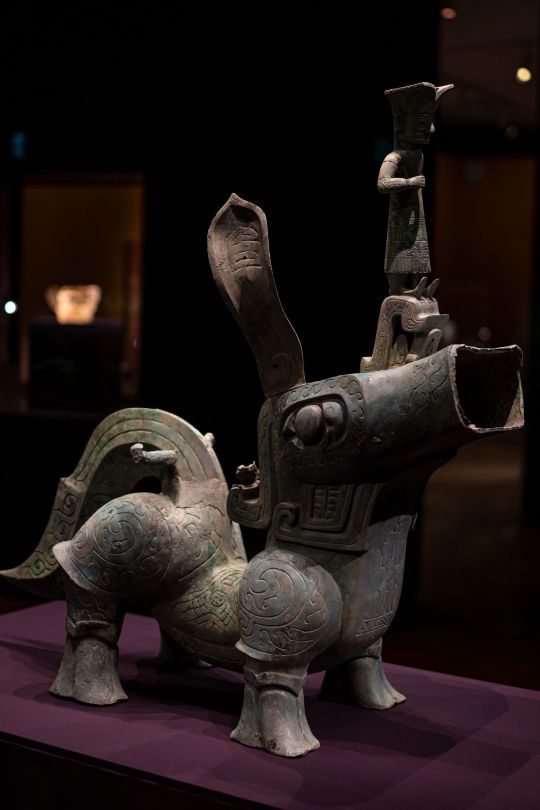
‘Historical myth’ of a continuous civilization
The exhibition places these items in the context of other ancient civilizations and includes the Shu among the many societies to have existed in the country’s “5,000-year history.” According to a press release from organizers, museum and Hong Kong government officials at the opening stressed the “continuity, inventiveness, unity, inclusiveness and emphasis on peace and harmony” of Chinese history.
Henry Tang, chairman of the governing body behind the West Kowloon Cultural District (where the Palace Museum is located) and a former candidate for Hong Kong’s top leadership role, said in a statement that the district and museum are looking to “promote cultural and artistic exchanges between China and the world, ‘tell China’s story well’, and strengthen the public’s cultural self-confidence.”
But the narrative that the Shu kingdom was innately Chinese is contentious, according to Ian Johnson, a senior fellow for China Studies at US think tank, the Council on Foreign Relations.
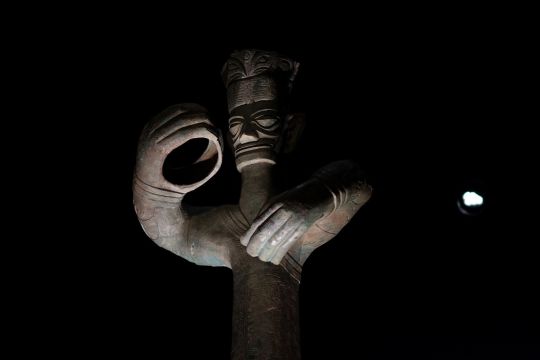
“Over the past few decades, the (Chinese Communist Party) has been trying to push a historical myth that all the peoples who have ever lived inside the current borders of the People’s Republic are ‘Chinese,’” he said over email.
“The basic idea is that the PRC (People’s Republic of China) encompasses people who naturally belong together and therefore, from today’s standpoint, form a nation. Hence any effort to have autonomy or even independence is taboo — it runs against history.”
The People’s Republic of China was established in 1949, and its government has often used China’s continuous history as evidence that ethnic groups such as the Tibetans and the Uyghurs have always belonged to China.

Johnson said that there was little support for the idea that civilizations along the Yellow River had much in common with those in the Sichuan Basin.
“They have commonalities but are not the same — just as ancient Assyrians and Phoenicians and Greeks weren’t the same, even if they shared certain things in common,” he said, adding: “sponsoring these kinds of exhibitions are popular and win the government credit.”
When asked to comment, the Hong Kong Palace Museum said the exhibition was “curated based on academic and archaeological research” and that it reinforces its mission to deepen audiences’ “understanding of the lives and cultures of various regions and ethnic groups as well as exchanges among them in ancient China, which have contributed to the magnificence of China’s civilization and its ‘diversity in unity’ pattern of development.”
By Christy Choi.
#‘Faces of Sanxingdui’: Bronze Age Relics Shed Light on Mysterious Ancient Kingdom#Chengdu Plain#Sanxingdui#Shu kingdom#gold artifacts#bronze artifacts#ancient artifacts#archeology#archeolgst#history#history news#ancient history#ancient culture#ancient civilizations#ancient china#ancient chinese#chinese history#chinese art#long post#long reads
31 notes
·
View notes
Text

Yibo Official Weibo update 2.8.2024 (part 6 of 6) Welcome to play UNIQ-Wang Yibo’s key frames of the year. Recall frame by frame, wonderful and colorful. Indulge in the beautiful changes of light and shadow, enjoy expressing your true self in music, explore the unknown in different fields, and progress in life. Keyframes are drawn one by one on the strip. In 2023, you will be rewarded with diligent study and hard work, and in 2024, we will embark on a new journey with steady steps! A new chapter is about to begin. I wish you all to move forward in the Year of the Dragon, and be happy and prosperous!
Part 6 Social Responsibility
Youth Responsibility / Public Welfare Empowerment
"The light of the fireflies, eventually converges into the brilliant galaxy."
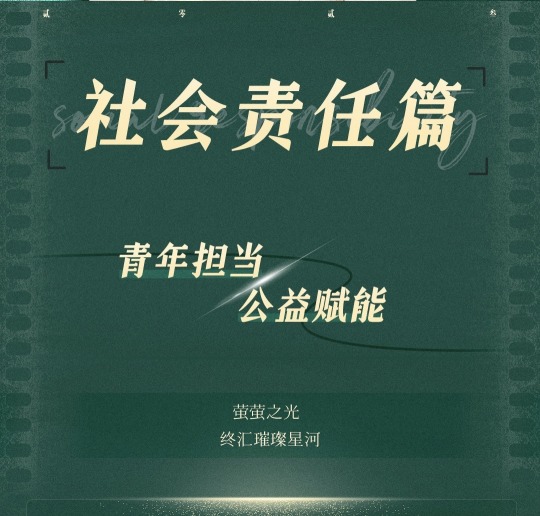
Luoyang Cultural Tourism Image Ambassador·
Promotion Ambassador of Luoyang Museum·
·Ice and Snow Sports Promotion Ambassador·
China Skateboarding Promotion Ambassador

China’s Top Dancer Promotion Ambassador·
WildAid Charity Ambassador
Emergency Management Publicity Ambassador
Luoyang Fire Protection Publicity Envoy
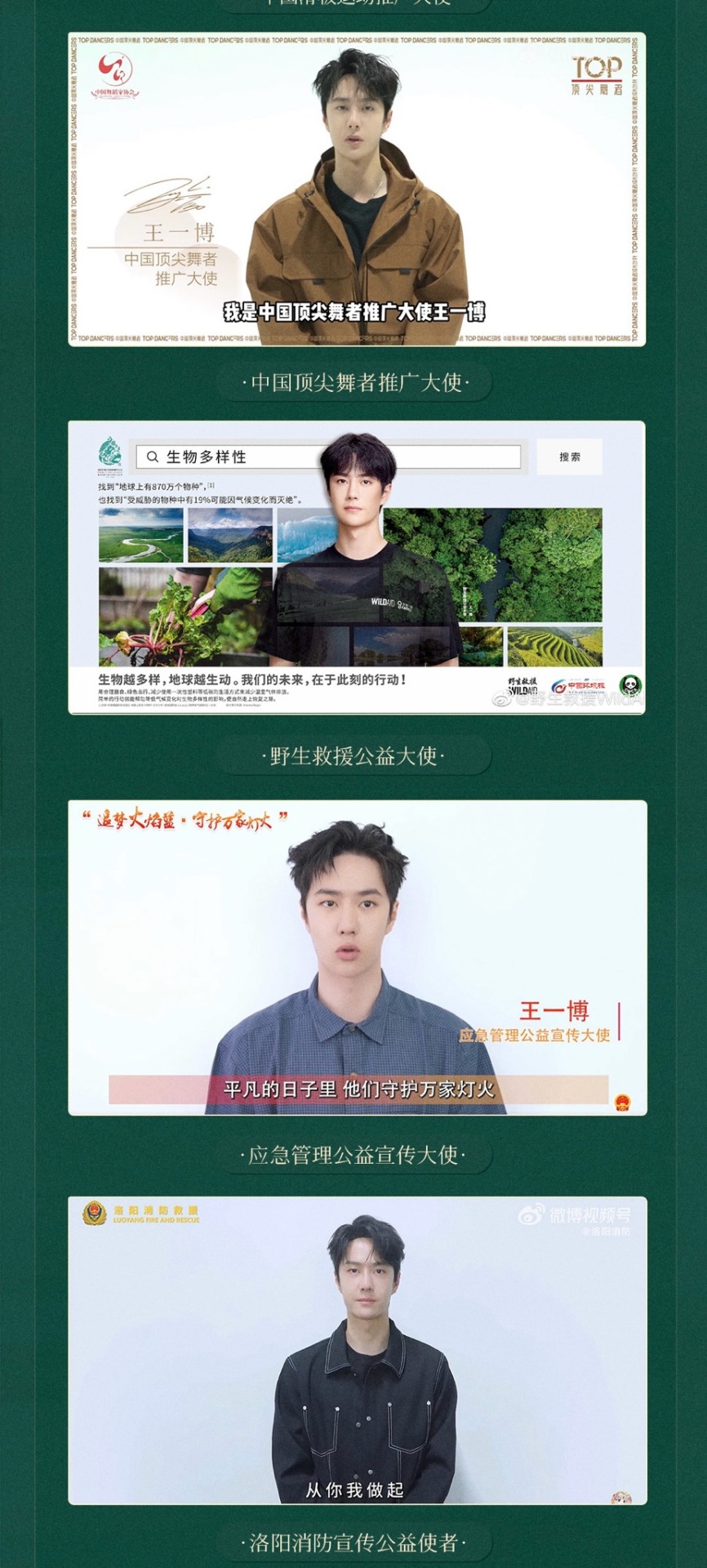
Reading Lei Feng’s diary to pay tribute to Lei Feng’s spirit
Literary and artistic volunteers walk with the people
Cyberspace Administration of China # Light Up the Light of Internet # Outstanding Youth Representatives
CALL for the Chengdu Universiade
Appeared in Hangzhou Asian Games· Break dance promotional video "Just Burning"
Lead by example and deliver positive energy
The year is over, the new year is waiting for 2024

Link here for parts 1-5
#wang yibo#Wang Yibo 2023 wrap up#and that’s it#it took awhile to finish this#but he did do a lot for 2023#and I like the part that they added his social responsibility work#thank you Yibo for sharing your talents with us
9 notes
·
View notes
Text
#architecture#amazingarchitecture#design#interiordesign#architect#archilovers#luxury#photooftheday#travel#architecturephotography#china#museum#zaha hadid#chengdu#zaha hadid architects
1 note
·
View note
Text




Meet Hui Ying Zhou✨
(her english name is Celestine)
a talented and inspiring woman born in the vibrant city of Chengdu, Sichuan. She is not only a dedicated single mom but also a flourishing Fashion Design professor at Britchester University, currently residing in the lively district of Shibuya, Tokyo, with her loving beau.
Beyond her role as a Fashion Design Professor, She is a visionary in the world of fashion, proudly owning her own fashion brand and studio situated in the eclectic atmosphere of San Myshuno. With a keen eye for design and a passion for creativity, she seamlessly weaves artistry into every fabric and stitch, leaving a lasting imprint on the fashion landscape.
While her days are filled with the hustle and bustle of the fashion world, Hui Ying's heart belongs to the canvas. A devoted painter, she finds solace and joy in expressing herself through art. Her dream? To one day establish her own art museum, a space where creativity knows no bounds and artistic voices echo through the halls.
Join Hui Ying's journey as she balances the realms of motherhood, academia, and entrepreneurship, weaving dreams into reality and leaving an indelible mark on the world of fashion and art.
8 notes
·
View notes
Note
you visited china? where specifically did you go? how was it?
This was back in 2009 so i’m sure stuff is different now, but yeah:
I visited Xi’an, Chengdu, Shanghai, and Beijing. Just a few days in each city. The trip was only two weeks long but it made a really strong impression on me. I visited some commonly visited landmarks, such as a part of the Great Wall, the Terracotta Warrior museum, a panda reserve, the Forbidden City, and Chairman Mao’s memorial site.
In general the people were friendly and openly curious about foreigners. (And I was an obvious foreigner as a white person.) But yeah when I would sit on a park bench and draw in my sketchbook, people would just come up to me and look at what I was drawing. Like, to the extent that at one point there were like two or three people looking over my shoulder. That practically never happens in America in my experience. And yeah even though my Mandarin speaking skill was really limited then (and is even more limited now since I’m so out of practice) people were usually pretty appreciative of my attempts to communicate.
That being said, the barter culture in marketplaces and stuff was kind of tough to deal with. It’s probably less common now, but there were certain stores where you were expected to barter, and if you didn’t, you’d end up way overpaying.
However, bartering is by no means a universal practice. I don’t think it’s ever practiced in, say, department stores or restaurants. It’s one of those cultural things that it seems you just have to know.
The food was amazing. Like, regardless of how expensive or cheap the food I had was, it was always great. And there is a lot of variety, and variation in cuisine in different regions.
I’m also a big appreciator of tea, and tea in china has a lot of variety and a lot better price for some really high-quality stuff. My favorite places to go were the tea houses, it’s like a café, often with outdoor seating, often with live traditional music, where you can just sit and drink tea and chat for hours.
If I ever get the opportunity go back, I would love to visit the north and the west of china. Like Xinjiang and Heilongjiang.
It would also be really cool if I could go see the Sino-Korean Friendship Bridge.
31 notes
·
View notes
Text
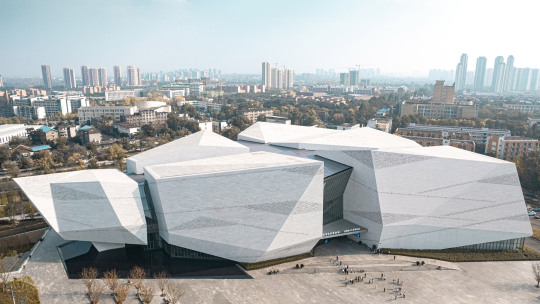
Mountain landscapes inform perforated-granite-clad Chengdu Natural History Museum
Faceted, rock-like forms clad with panels of perforated granite define the Chengdu Natural History Museum in China, which was designed by US studio Pelli Clarke & Partners and local studio CSWADI.
Completed in 2022, the 50,000-square-metre museum is part of a developing "entrepreneurial hub" in Chengdu, combining public spaces, shops and a cafe with galleries, a cinema and educational facilities.


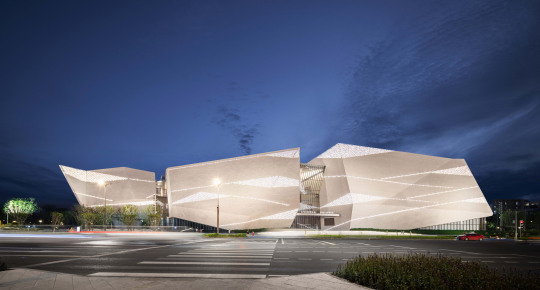
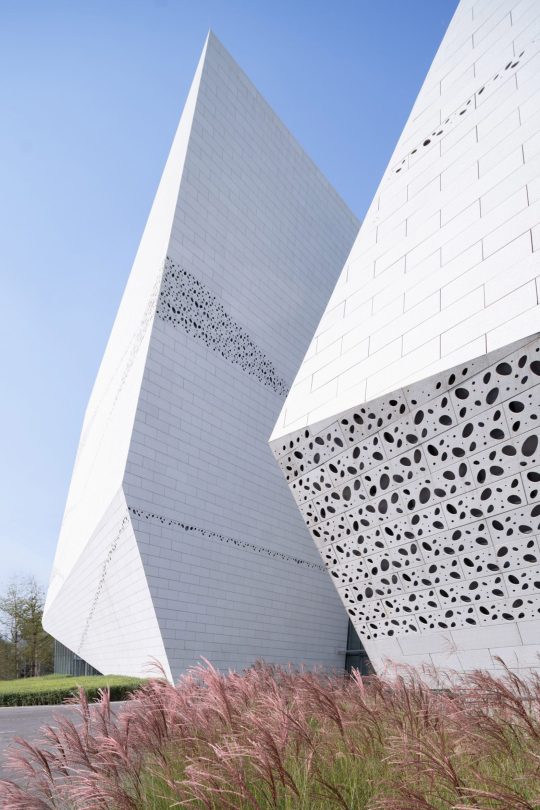
#chengdu natural history museum#china#pelli clarke & partners#architecture#architectural studio#museum#cswadi#design studio#granite#perforated granite clad
0 notes
Text
[SCHEDULE] EXO's Schedule for November (2023)
[RELEASE] - Music releases; [BIRTHDAY] - Birthdays; [PERF]️ - Performance events; [SIGN] - Fan-signing events; [MEET] - Fan-meeting events; [BROADCAST] - Live or pre-recorded televised broadcasts; [RADIO] - Radio broadcasts; [REC] - Programme pre-recordings; [LIVE] - Live streams; [AWARD] - Award ceremonies; [OTHER] - Other events.
Only confirmed schedules are included. The number of entries will grow as further schedules are announced.
(Last updated: 231123)
November 3
[BROADCAST] tvN KongKongPatPat Ep.4 (tvN 콩콩팥팥 제4회) - 20:40 KST - (D.O.)
[PERF] 2023 On Music Festival - (Manila, Philippines) - (Suho)
November 4
[MEET] Allo Bank Hangout: Meet and Greet in Indonesia - (Baekhyun)
[PERF] Grand Line #3: Boundless Journey in Nanjing - 19:30 CST - (Lay)
[PERF] Fancon Tour 'The Eternity' in Taoyuan - 18:00 CST - (Chanyeol)
November 6
[OTHER] 2023 National Museum of Korea Appreciation and Support Night (2023 국립중앙박물관 감사와 후원의 밤) - (Baekhyun)
November 10
[BROADCAST] tvN KongKongPatPat Ep.5 (tvN 콩콩팥팥 제5회) - 20:40 KST - (D.O.)
[PERF] K-Content Expo in UAE 2023: Korea Spotlight - (Chanyeol)
November 11
[PERF] 9Wave Music Festival - 18:00 ICT - (Surf Beach, Sunway Lagoon, Selangor, Malaysia) - (Xiumin)
[PERF] Grand Line #3: Boundless Journey in Guangzhou - (Lay)
November 14
[OTHER] Monsta X member Hyungwon's enlistment send-off - (Xiumin)
November 15
[OTHER] League of Legends Worlds 2023 Media Day - (Bekhyun)
November 17
[BROADCAST] tvN KongKongPatPat Ep.6 (tvN 콩콩팥팥 제6회) - 20:40 KST - (D.O.)
November 18
[PERF] Fancon Tour 'The Eternity' in Bangkok - 18:00 ICT - (Chanyeol)
[PERF] Grand Line #3: Boundless Journey in Chengdu - (Lay)
November 19
[OTHER] League of Legends Worlds 2023 Opening Ceremony - (Baekhyun)
November 23
[OTHER] Attending FT Island’s concert in Tokyo - (Xiumin)
November 24
[BROADCAST] tvN KongKongPatPat Ep.7 (tvN 콩콩팥팥 제7회) - 20:40 KST - (D.O.)
November 25
[PERF] Fancon Tour 'The Eternity' in Hong Kong - 19:00 CST - (Chanyeol)
November 27
[BIRTHDAY] Chanyeol's Birthday
[OTHER] Happy Sweet Chanyeol Day - 19:00 KST - (Chanyeol)
Credit: dailyexo.tumblr.com. Material not to be redistributed in part or whole without prior permission.
8 notes
·
View notes
Text
The Mysterious Sanxingdui(part1)
The Sanxingdui site is known as the "Ninth Archaeological Wonder".
三星堆遗址,世称“第九大考古奇迹”。

The title rings a bell, but have you ever wondered: why do we pay so much attention and importance to the site of Sanxingdui?
这个称号如雷贯耳,但你有没有想过:为什么我们会如此关注和重视三星堆遗址呢?
Because the artifacts excavated from them are all too stunning and peculiar. Bronze large standing man, bronze sphinx, bronze mask, bronze sacred tree ......
因为从其中出土的文物都太惊艳,也太奇特了。 青铜大立人、青铜人面像、青铜面具、青铜神树……
The form of these excavated bronzes, which are rarely seen in previous sites of ancient civilizations, is more like a collection of giant "handicrafts" than a vessel or musical instrument with obvious utility.
这些已出土青铜器的形态,在以往的古文明遗址中都很少见,相比于具有明显实用性的容器或者乐器,它们更像是一批巨大的“手办”。
In the Xia and Shang dynasties of the Central Plains at that time, even though bronze technology had developed to a certain level, there was still no tradition of making statues of gods and human figures in bronze.
而在当时中原的夏商王朝,尽管青铜器技术已经发展到了一定水平,也仍然不存在用青铜制作神像、人像的传统。
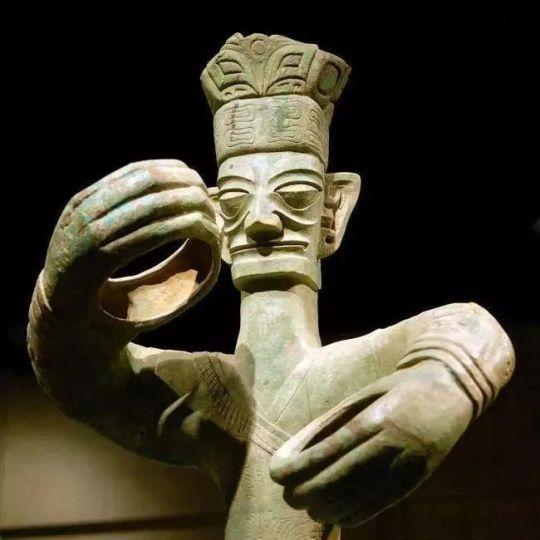
It's amazing, for what reason did the ancestors of Sanxingdui make these "handicrafts"?
这就很奇妙了,三星堆先民是出于什么原因造出了这些“手办”的呢?
Why is the ancient Shu civilization buried under the site of Sanxingdui so different from the civilization of the Middle Kingdom?
埋藏在三星堆遗址下的古蜀文明,又为什么会跟中原文明有如此大的差别?
ould this be a civilization independent of the Central Plains?
难道这是一个独立于中原的文明吗?
Everything still has to go back to the history of the ancient Shu state a thousand years ago to find out.
一切还得要回溯到千年前古蜀国的历史里,去一探究竟。
Legend has it that the first chief of the ancient kingdom of Shu named Cancong, ancient books record that he had a pair of peculiar "vertical eyes", eyes are not only particularly large, but also double protruding forward, extraordinary eyesight.
传说古蜀国的第一位首领名叫蚕丛,古书里记载,他有一双奇特的“纵目”,眼睛不仅特别大,还双双向前突出,视力非同一般。

Before the establishment of the ancient Shu Kingdom, Cancong led the Cancong tribe to live in the area of Minshan Mountain, where the terrain of the peaks and valleys, deep river valleys, people can only live by the mountains and caves, the conditions are very difficult.
在建立古蜀国以前,蚕丛率领着蚕丛氏部落生活在岷山一带,那里的地势峰峦叠嶂、河谷深切,人们只能依山凿洞而居,条件非常艰苦。
Then one day, he was patrolling the mountains and surprisingly, with his longitudinal eyes, he saw from afar that the Chengdu Plain was open and fertile for thousands of miles, which was perfect for living.
后来有一天,他在山间巡逻,竟然用自己的纵目远远看见成都平原地势开阔、沃野千里,非常适合居住。
After returning, Cancong immediately led the tribe to trek through the mountains and water, migrated to the Chengdu Plain, where the kingdom was established. Later, the ancestors of the tribe remembered Cancong and wished they could also have a pair of sharp eyes, so they made a bronze longitudinal eye mask specifically according to the appearance of Cancong, and gradually formed the unique eye cult of the ancient Shu people.
回来以后,蚕丛就立刻带领部落跋山涉水,迁徙到了成都平原,在此建国称王。 后来,部落先民感念蚕丛,又希望自己也能拥有一双目力超群的犀利眼睛,就专门按照蚕丛的样子,制作了一副青铜纵目面具,同时也逐渐形成了古蜀人独特的眼睛崇拜。
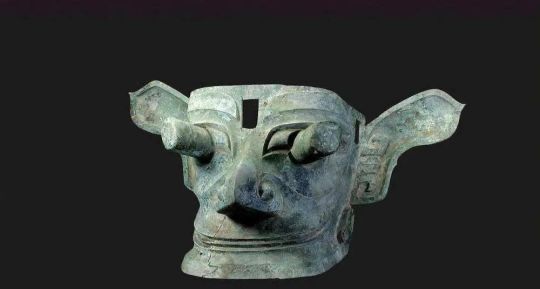
The mask is now on display at the Sanxingdui Museum and is one of the "six national treasures" of Sanxingdui.
这副纵目面具现在陈列于三星堆博物馆,是三星堆“六大国宝”之一。
It is majestic and imposing, so large that it took four or five people to lift it when it was unearthed, so you can imagine that it could not be worn.
它造型雄奇,威风凛凛,体积非常庞大,出土的时候需要四五个人才能合力抬起来,可想而知,这根本没法拿来佩戴。
A more likely scenario is that it was treated as an incarnation of the ancient Shu king Cancong Clump and placed in the center of some altar to be worshipped by the ancient Shu ancestors.
更有可能的情况是,它被当作古蜀王蚕丛的化身,摆在了某个祭坛中央,接受古蜀先民的祭拜。
In addition to the longitudinal eye mask, archaeologists have unearthed five eye-shaped ornaments, 71 eye-shaped bronze objects, and 33 eye bubbles in one site pit alone - not counting the various eye symbols on other artifacts.
除了纵目面具以外,考古工作者们光光在一个遗址坑里,就发掘了5件眼形饰、71件眼形铜器、33件眼泡——还没算上其他文物上各种各样的眼睛符号。
This shows how important eye worship was in the beliefs of the ancient Shu ancestors at that time.
可见当时在古蜀先民的信仰观念里,眼睛崇拜是一项多么重要的内容。
75 notes
·
View notes
Text
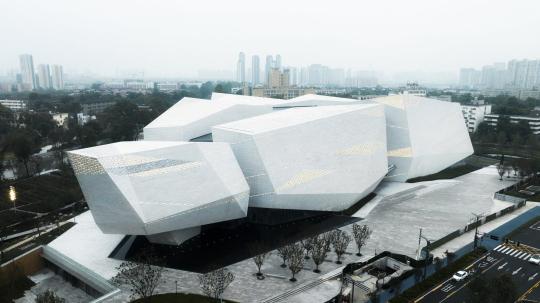
0 notes